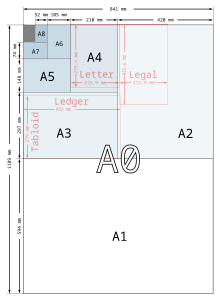From Wikipedia, the free encyclopedia
Many paper size standards and conventions have existed at different times and in different countries. Today there is one widespread international ISO standard (including A4, B3, C4, etc.) and a localised standard used in North America (including letter, legal, ledger, etc.). The paper sizes affect writing paper, stationery, cards, and some printed documents. The standards also have related sizes for envelopes.
The international standard: ISO 216
The international paper size standard, ISO 216, is based on the German DIN 476 standard for paper sizes. ISO paper sizes are all based on a single aspect ratio of square root of 2, or approximately 1:1.4142. The base A0 size of paper is defined to have an area of one m². With the given aspect ratio of square root of two, this corresponds to a piece of paper which its longer side is one metre multiplied by the square root of the square root (that is, the fourth root) of two and the shorter side being the inverse of this value. Rounded to millimetres the A0 paper size is 841 by 1,189 millimetres (33.1 × 46.8 in).
Successive paper sizes in the series A1, A2, A3, and so forth, are defined by halving the preceding paper size along the larger dimension. The most frequently used paper size is A4 (210 × 297 mm).
The main advantage of this system is its scaling: if a sheet with an aspect ratio of √2 is divided into two equal halves parallel to its shortest sides, then the halves will again have an aspect ratio of √2. Folded brochures of any size can be made by using sheets of the next larger size, e.g. A4 sheets are folded to make A5 brochures. The system allows scaling without compromising the aspect ratio from one size to another—as provided by office photocopiers, e.g. enlarging A4 to A3 or reducing A3 to A4. Similarly, two sheets of A4 can be scaled down and fit exactly 1 sheet without any cutoff or margins. Weights are easy to calculate as well: a standard A4 sheet made from 80 gram/m² paper weighs 5 grams (as it is one 16th of an A0 page, measuring 1 m²), allowing one to easily compute the weight—and associated postage rate—by counting the number of sheets used.
The advantages of basing a paper size upon an aspect ratio of √2 were already noted in 1786 by the German scientist and philosopher Georg Christoph Lichtenberg (in a letter to Johann Beckmann). Early in the twentieth century, Dr Walter Porstmann turned Lichtenberg's idea into a proper system of different paper sizes. Porstmann's system was introduced as a DIN standard (DIN 476) in Germany in 1922, replacing a vast variety of other paper formats. Even today the paper sizes are called "DIN A4" in everyday use in Germany. The term Lichtenberg ratio has recently been proposed for this paper aspect ratio.
The DIN 476 standard spread quickly to other countries. Before the outbreak of World War II, it had been adopted by the following countries:
|
|
|
During World War II, the standard was adopted by Uruguay (1942), Argentina (1943) and Brazil (1943); and afterwards spread to other countries:
|
By 1975 so many countries were using the German system that it was established as an ISO standard, as well as the official United Nations document format. By 1977 A4 was the standard letter format in 88 of 148 countries. Today the standard has been adopted by all countries in the world except the United States and Canada. In Mexico, Colombia, Venezuela, Argentina, Chile and the Philippines the US letter format is still in common use, despite their official adoption of the ISO standard.

A size chart illustrating the ISO A series and a comparison with American letter and legal formats.
A size chart illustrating the ISO B series.
In addition to the A series, there is a less common B series. The area of B series sheets is the geometric mean of successive A series sheets. So, B1 is between A0 and A1 in size, with an area of 0.707 m² (√0.5). As a result, B0 is 1 metre wide, and other sizes in the B series are a half, a quarter or further fractions of a metre wide. While less common in office use, it is used for a variety of special situations. Many posters use B-series paper or a close approximation, such as 50 cm×70 cm; B5 is a relatively common choice for books. The B series is also used for envelopes and passports.
The C series is used only for envelopes and is defined in ISO 269. The area of C series sheets is the geometric mean of the areas of the A and B series sheets of the same number; for instance, the area of a C4 sheet is the geometric mean of the areas of an A4 sheet and a B4 sheet. This means that C4 is slightly larger than A4, and B4 slightly larger than C4. The practical usage of this is that a letter written on A4 paper fits inside a C4 envelope, and a C4 envelope fits inside a B4 envelope.
http://en.wikipedia.org/wiki/Paper_size


No comments:
Post a Comment